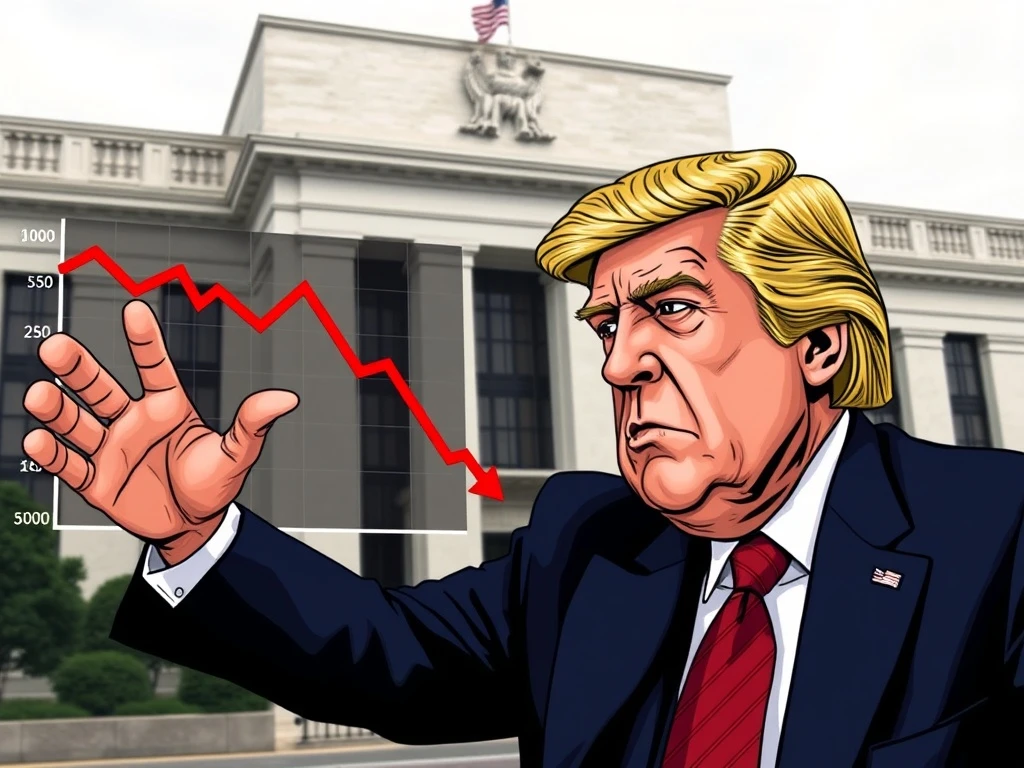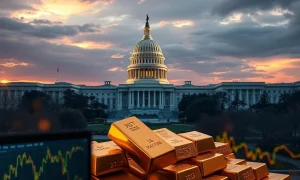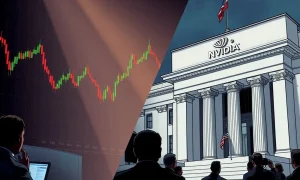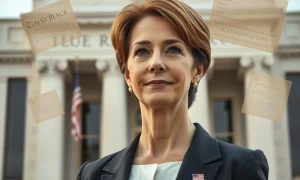Many observers expressed confusion when President Trump frequently called for the Federal Reserve to lower interest rates. This stance marked a departure from traditional presidential rhetoric concerning the central bank’s independence. Understanding the motivations behind **Trump rate cuts** requires examining economic principles and political dynamics. Therefore, this article explores the core reasons driving the former president’s strong advocacy for reduced borrowing costs, aiming to clarify a complex economic debate.
Understanding the Federal Reserve and **Trump Rate Cuts**
The Federal Reserve, often called the Fed, operates as the central bank of the United States. Its primary mandates are to maintain maximum employment and stable prices. To achieve these goals, the Fed uses various monetary policy tools, most notably adjusting the federal funds rate. This rate influences borrowing costs throughout the economy. Historically, presidents have respected the Fed’s independence to prevent political interference from skewing economic policy. However, President Trump frequently broke with this tradition, openly criticizing the Fed’s decisions and urging for significant **Trump rate cuts**.
His public statements often highlighted a belief that the Fed was hindering economic growth. For instance, he argued that higher rates made U.S. exports more expensive. Furthermore, he believed they strengthened the dollar too much, disadvantaging American businesses in global markets. This direct pressure created an unusual dynamic between the White House and the central bank.
The Economic Rationale for Lower Rates
President Trump’s arguments for lower rates stemmed from several economic perspectives. He consistently articulated a desire for faster economic growth and stronger market performance. Consequently, he viewed the Fed’s monetary policy as a barrier to these objectives. Let’s explore his key rationales:
- Stimulating Growth: Lower interest rates typically encourage borrowing and spending. Businesses can invest more cheaply, expanding operations and creating jobs. Consumers also find it more affordable to take out loans for homes or cars, boosting demand. President Trump believed the U.S. economy could grow even faster with more accommodative monetary policy.
- Countering Global Slowdown: The global economy faced headwinds during his presidency, including trade tensions and slower growth in major economies like China and Europe. He argued that the U.S. needed lower rates to remain competitive and to insulate itself from these external pressures. This perspective highlighted the interconnectedness of global finance.
- Weakening the Dollar: A stronger dollar makes U.S. goods more expensive for foreign buyers. This can hurt American exports and worsen the trade deficit, a key concern for the administration. Conversely, lower rates tend to weaken a currency, potentially making U.S. products more attractive abroad. Therefore, **Trump rate cuts** were seen as a tool to boost exports.
- Trade War Leverage: The administration engaged in significant trade disputes, particularly with China. Lower interest rates could provide some economic cushion during these periods of uncertainty. This approach aimed to mitigate any negative impact on domestic growth while trade negotiations proceeded.
The Debate Surrounding **Trump Rate Cuts**
While President Trump’s calls for lower rates were clear, the rationale sparked considerable debate among economists and policymakers. Many argued that the U.S. economy was already performing well, with low unemployment and steady growth. In such conditions, aggressively cutting rates could carry risks. For instance, it might fuel inflation or create asset bubbles.
Furthermore, the independence of the Federal Reserve is a cornerstone of sound economic policy. Political pressure on the central bank can undermine its credibility and effectiveness. Experts worry that a Fed perceived as politically motivated might lose the market’s trust. This could lead to unpredictable economic outcomes. Ultimately, the debate centered on balancing short-term growth desires with long-term economic stability and institutional integrity.
The Fed’s Perspective on Interest Rate Policy
The Federal Reserve operates with a dual mandate: achieving maximum employment and maintaining price stability. Its decisions are based on economic data, not political preferences. When the Fed raises rates, it typically aims to prevent the economy from overheating. This helps to control inflation. Conversely, rate cuts are usually reserved for stimulating a sluggish economy or combating a recession. During the period of **Trump rate cuts** advocacy, the Fed was navigating a robust economy, making the president’s demands particularly contentious.
Chairman Jerome Powell consistently affirmed the Fed’s independence. He emphasized that decisions were made based on data and the Fed’s mandates. Despite presidential criticism, the Fed maintained its focus on these core objectives. This commitment to independence is crucial for global financial stability. It ensures that monetary policy serves the broader economic good, not specific political agendas.
Potential Consequences of Politically Motivated **Trump Rate Cuts**
Economists often warn about the dangers of a central bank losing its independence. If interest rate decisions become political, several negative consequences could arise. Firstly, it could lead to an inflationary spiral. A government might push for lower rates to fund spending, leading to too much money chasing too few goods. Secondly, it could create asset bubbles. Artificially low rates can inflate prices for stocks or real estate beyond their fundamental value, risking a sharp correction later.
Moreover, investor confidence could erode. Markets rely on predictable and independent monetary policy. If investors perceive that political whims dictate rates, they may become hesitant to invest. This uncertainty can deter both domestic and foreign investment. Ultimately, such a scenario could undermine the stability of the entire financial system. Therefore, the calls for **Trump rate cuts** by presidential decree raised significant concerns among financial experts.
Historical Context of Presidential Influence
While President Trump’s public pressure on the Fed was unusual, it was not entirely unprecedented for presidents to express views on monetary policy. Historically, however, such expressions were often more subtle or occurred behind closed doors. For example, President Lyndon B. Johnson reportedly pressured then-Fed Chair William McChesney Martin Jr. in the 1960s to keep rates low. This pressure aimed to fund the Vietnam War and his Great Society programs without raising taxes.
Similarly, President Richard Nixon exerted influence on Fed Chair Arthur Burns in the early 1970s. This period saw inflationary pressures build, partly due to expansionary monetary policy. However, these instances were typically less overt than the daily public critiques seen during the Trump administration. The shift to highly public and persistent calls for **Trump rate cuts** represented a new chapter in the relationship between the White House and the Federal Reserve.
The Impact on Public Perception and Markets
The constant public debate over **Trump rate cuts** undoubtedly affected public perception. It highlighted the tension between a president focused on immediate economic metrics and a central bank committed to long-term stability. For the general public, it likely fueled confusion about the Fed’s role and independence. Meanwhile, financial markets closely watched these exchanges.
Markets generally prefer stability and predictability in monetary policy. Persistent uncertainty or perceived political interference can introduce volatility. While some market participants might have welcomed lower rates, others worried about the precedent being set. Ultimately, the episode underscored the delicate balance required in managing economic policy and maintaining institutional integrity. The discussion continues to inform future debates on central bank independence.
In conclusion, President Trump’s desire for significant **Trump rate cuts** stemmed from a clear economic philosophy focused on accelerating growth, boosting exports, and providing leverage during trade disputes. While his arguments had some theoretical basis, they clashed with the Federal Reserve’s commitment to independence and its data-driven approach to monetary policy. The ensuing debate highlighted fundamental questions about the central bank’s role, the risks of political interference, and the long-term health of the U.S. economy. Understanding this dynamic is crucial for anyone interested in the interplay of politics and economics.
Frequently Asked Questions (FAQs)
Why did President Trump want **Trump rate cuts**?
President Trump believed lower interest rates would stimulate faster economic growth, make U.S. exports more competitive by weakening the dollar, and provide a buffer during trade wars. He felt the Federal Reserve’s higher rates were hindering the economy’s potential.
What is the Federal Reserve’s primary role?
The Federal Reserve’s primary roles are to achieve maximum employment and maintain price stability (control inflation). It uses tools like adjusting the federal funds rate to influence the economy and meet these mandates.
Why is Federal Reserve independence important?
Federal Reserve independence ensures that monetary policy decisions are based on economic data and long-term stability goals, rather than short-term political pressures. This helps maintain the central bank’s credibility and prevents inflationary spirals or asset bubbles.
What are the potential risks of politically influenced interest rates?
Politically influenced interest rates can lead to several risks. These include uncontrolled inflation, the formation of asset bubbles, erosion of investor confidence, and ultimately, instability in the financial system. Such interference can undermine the central bank’s effectiveness.
How do interest rates affect the U.S. dollar?
Higher interest rates typically make a country’s currency more attractive to foreign investors, strengthening it. Conversely, lower interest rates tend to make the currency less appealing, leading to a weaker dollar. A weaker dollar can boost exports by making them cheaper for foreign buyers.








